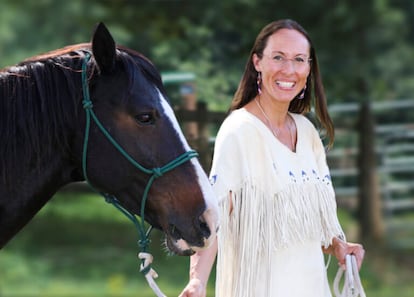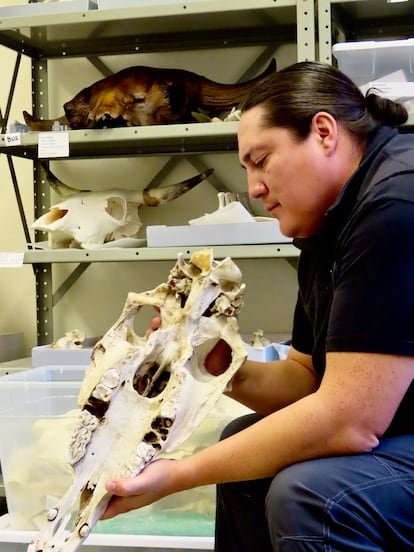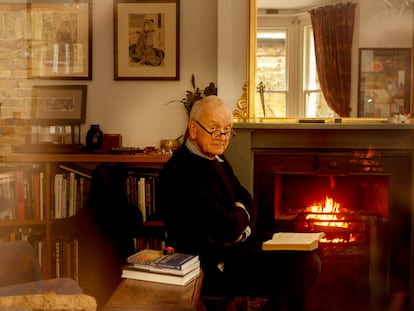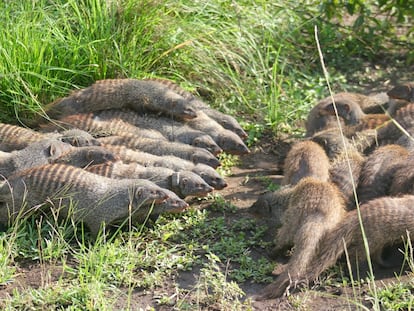Native Americans adopted Spanish horses before colonization by other European powers
New archaeological evidence conducted in tandem with local communities suggests the ‘introduction of Spanish-sourced domestic horses into Indigenous societies across the plains before the first half of the 17th century’

The first time the Native Americans saw a Spanish soldier riding his horse, they didn’t understand what they were seeing.
Historical chronicles speak of a first exploratory mission with a couple of dozen horses and some mares. The Indigenous people recorded how, in 1519, the horses belonging to the Spanish conquistador Hernán Cortés looked like centaurs – half-man and half-horse. Thus, to them, it appeared as if the horse and the rider were a single entity.
Today, a multidisciplinary investigation – involving almost 100 scientists from around the world and 66 centers and institutions – details how the image of a human-horse was a constant among the Indo-American tribes on the plains of the United States during the first half of the 17th century, before the rest of the European colonizers arrived.
At least since the Spanish conquest of America from the south, during the viceroyalty of New Spain, horses had already begun to spread northward from the frontier settlements in New Mexico. The new dating of fossils has found that the domesticated equine presence was actually 200 years earlier than previously thought. A “strong genetic affinity” has been found between contemporary horse herds and the Spanish equestrian population from centuries ago.

The modern wild horse had roamed the American continent thousands of years before the conquest, during the Pleistocene epoch, before becoming extinct in North America. Hence, for the authors of the work – which was published at the end of March in the journal Science – it was undeniable that there had been contact between wild and domesticated horses.
One of the unknowns that the new evidence helps answer is that, after the disappearance of wild horses 13,000 years ago during the Ice Age, the equines found in the American West had undoubtedly “strong Iberian genetic affinities.” These Spanish horses came from Eurasia across the Atlantic, disembarking in the Caribbean with the troops of the Spanish Empire, towards the beginning of the 17th century.
This research stems from a pioneering collaboration between institutional science and the tribes of the Great Plains of the United States, involving scientists of Comanche, Pawnee and Lakota origin, among other Indigenous tribes.
Researcher Yvette Collins – from the Toulouse Center for Anthropobiology and Genomics (CAGT) in France – is also known as “Running Horse” (tašunke iyanke wiŋ). She hails from the Lakota tribe on the Indian reservation in Pine Ridge, South Dakota. The scientist explains that it was “time to join other Indigenous communities and welcome scientific research.”
Collins notes that a study was set up to analyze the past of horses – a species that plays a key role in the cosmogony and culture of Native Americans. The Lakota group, for instance, calls itself sungwakaŋ, which means “horse nation” in Sioux.

“From the Lakota point of view, horses are in the same category as a person… our experience with them is different,” Collins explains.
As a member of the tribe and from her experience as a researcher, she offers a new way of looking at things: “We don’t use fences or corrals with the horses – we present the animals as part of the clan. They are sacred.”
Her interest in scientific knowledge and the history of horses is what has motivated this interdisciplinary study, as well as the fact that her society has been one of the first Indigenous groups to open the doors to external researchers.
“This is something historic,” says French geneticist Ludovic Orlando, also from the CAGT. He’s a co-author of the recent study and has been researching the evolution of horses for more than 15 years.
“Of course, what we’ve discovered about the reappearance of these animals in the US is important, but [the fact] that Indigenous people are collaborating with geneticists is unique.”
Orlando thinks that, regardless of the ideas that the publication reveals, what is vital is that “it’s the first time that the Amerindian societies themselves have carried out the analyses.”
The research takes advantage of the archaeological remains of the first historical specimens of horses, instead of being based on the European conquerors’ records, which are riddled with “omissions, inaccuracies and a strong anti-Indigenous bias.” The authors note that this error was made “with many previous studies.”
The horse was (and is) essential for many Indigenous residents of the American Southwest to be able to navigate the Great Plains – an area of over one million square miles that crosses the entire Midwest of the continent, from north to south, connecting Mexico and Canada. Archaeologist William Taylor – who teaches at the University of Colorado and is a co-author of the study – explains that, after having located an equestrian fossil with torsion marks on its muzzle, this points to the fact that the mount was ridden by Amerindians. Furthermore, the relic presents healed wounds in its bone record, indicating that the Indigenous cared for injured horses.
Taylor is a researcher specializing in Mongolia. “The Asian record of the relationship with horses is completely different from what we find in the Indigenous West.” Among the details found from analyzing the 30 bone remains with osteological, genomic, isotopic, radiocarbon and paleopathological tests, signs found in the skull indicate that there was expert coordination between the rider and the horse.

Federico Navarrete – a specialist in Mesoamerican studies from the National Autonomous University of Mexico, who didn’t participate in the study – describes how the horse formed a deeper relationship with the tribes north of the Mississippi River due to the “hunter-gatherer character and nomadic nature of Native Americans” across the American prairies.
Meanwhile, in central Mexico, the historian points out, “for the Mesoamerican Indigenous peoples, [horses] weren’t so useful, nor an element of significant exchange.” Another animal that was domesticated in the Middle East and transported transatlantically by Columbus in 1492 played a more important role for the Mexica: the sheep.
“In [central Mexico], they liked sheep better, [because] they gave wool quickly, they could be eaten and they could be raised anywhere. They became very important,” Navarrete emphasizes.
From being a key player in the world of the 19th and early-20th centuries, Orlando laments the disappearance of horses: “A loss in animal lives, but also in culture.” And he comments ironically how “at this moment, there are more French people – around 70 million – than horses in the Western world. One hundred years ago, this would have been unthinkable, when in Paris or New York, there were even problems with dung – [there was] a big crisis with horse dung.”
For this scientist, the main success of the research is how they approached the subject matter: “The worst thing we could have done is ‘helicopter science’ – go to these communities, do our studies and leave without relating to them.”
Collins – who emphasizes how the science of the Lakota emphasizes the preservation and equal treatment of the horse – is optimistic about more work with Indigenous communities: “This is the first of many research projects.”
Sign up for our weekly newsletter to get more English-language news coverage from EL PAÍS USA Edition
Tu suscripción se está usando en otro dispositivo
¿Quieres añadir otro usuario a tu suscripción?
Si continúas leyendo en este dispositivo, no se podrá leer en el otro.
FlechaTu suscripción se está usando en otro dispositivo y solo puedes acceder a EL PAÍS desde un dispositivo a la vez.
Si quieres compartir tu cuenta, cambia tu suscripción a la modalidad Premium, así podrás añadir otro usuario. Cada uno accederá con su propia cuenta de email, lo que os permitirá personalizar vuestra experiencia en EL PAÍS.
¿Tienes una suscripción de empresa? Accede aquí para contratar más cuentas.
En el caso de no saber quién está usando tu cuenta, te recomendamos cambiar tu contraseña aquí.
Si decides continuar compartiendo tu cuenta, este mensaje se mostrará en tu dispositivo y en el de la otra persona que está usando tu cuenta de forma indefinida, afectando a tu experiencia de lectura. Puedes consultar aquí los términos y condiciones de la suscripción digital.
More information
Últimas noticias
A floating school teaches children how to save Lake Atitlán
Pablo Escobar’s hippos: A serious environmental problem, 40 years on
From Andorra to Gibraltar, a black market for Ozempic exploits its success: ‘They’re the most sought-after products in the world’
The brief rise and retreat of Generation Z in Mexico
Most viewed
- Why we lost the habit of sleeping in two segments and how that changed our sense of time
- Charles Dubouloz, mountaineering star, retires at 36 with a farewell tour inspired by Walter Bonatti
- Venezuela faces its most tense Christmas yet
- CBS in crisis after pulling a report on Trump’s deportations to El Salvador (which later leaked online)
- Bukele clan fumes over investigation exposing their new wealth










































